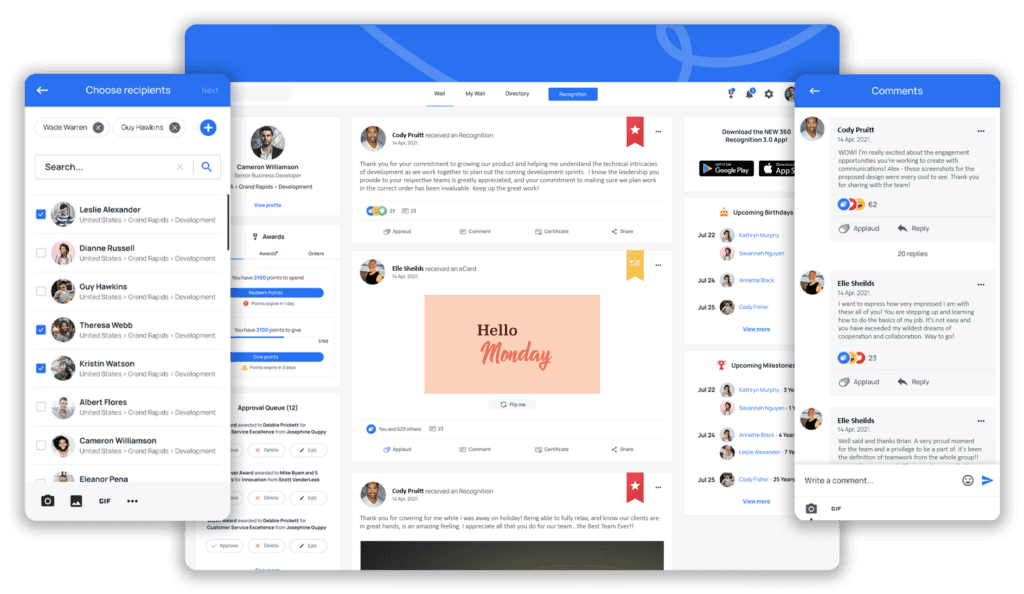August 3, 2023


In today's fast-paced and competitive business environment, companies are increasingly realizing the importance of creating a positive and motivating workplace culture.
In order to achieve this kind of culture, employee recognition is an essential element. More and more research is finding that recognition is a powerful tool that can boost employee engagement and morale, as well as boost productivity and reduce turnover.
Here, we'll delve into the significance of building a culture of recognition at work and explore effective strategies to implement it.
What is an Employee Recognition Program?
Employee recognition is just as it sounds - recognizing and thanking employees for their hard work and effort. It incorporates all the ways an organization shows its appreciation for employees.
This can take many forms from words of affirmation to monetary bonuses.
An employee recognition program, on the other hand, is a formal strategy that companies adopt with the purpose of building recognition into the company's culture.
While it may include a casual thank you in the hallway, formal employee recognition programs don't rely on this alone.
Instead, an employee recognition program has structure. Recognition is typically driven by company values, have leadership buy-in, and is utilized often.
Typically, employee recognition programs encourage recognizing employees for things like:
- Exhibiting company values, like showing innovation on a project or collaborating well
- Going above and beyond expectations
- Milestones, like a 5-year anniversary
- Sales, wellness, or safety incentives
- Being a positive presence in the office

Types of Employee Recognition Programs
There are many different types of employee recognition programs, but they can generally be classified into three main categories.
Social/Peer-to-Peer Recognition
As the name suggests, peer recognition occurs when employees express appreciation for their colleagues. This is sometimes also known as social recognition.
A peer recognition program is a structured plan that builds recognition into a company’s culture.
Some peer recognition programs are housed via an online employee recognition platform that's accessible to all employees in a company, similar to how social media platforms operate.
Peer-to-peer recognition can be a great way to open up recognition to the whole company and really build recognition into the company culture, all while taking some of the responsibility off of managers' shoulders.
This isn’t to say that managers can skip out on recognition. In fact, managers oftentimes need to lead by example to win employee buy-in.
But once a social recognition platform has been implemented and adopted, recognition is truly owned by everyone.
Service and Milestone Awards
One of the most common types of recognition is employee service awards. And for many years, it was typically the only form of employee recognition.
Some companies use the terms "milestone" and "service" interchangeably. Others, break up service awards as awards given to employees after a certain amount years of with a company.
This can be one year, five years, ten years, and so one.
Milestone awards can be a bit broader and are given when an employee reaches a particular milestone.
This can be reaching a certain sales target, completing a specific set of training, or reaching a significant amount of years with a company. In this way, a milestone award can be considered a type of service award as well.
While these programs have been around for decades, they've changed significantly over the years.
Today, employers can celebrate their employees' tenure with points given on their social recognition or employee reward platform, a shopping experience through an online storefront, or opt for a customized plaque or pin.


Incentive Programs
Employee incentives are a way to motivate your employees to achieve certain goals. These incentives oftentimes come in a few forms, including:
- Sales - A sales incentive is a reward offered to salespeople to help motivate them towards a goal.
- Performance - Similar to a sales incentive, a performance incentive is broader to include teams outside of sales. This might look like the Marketing team winning a reward for reaching record high organic web traffic.
- Safety - Safety incentives motivate people in hazardous roles to take the the necessary precautions to minimize incidents.
Rewards for achieving these goals could be a monetary bonus, a custom award, extra PTO, or anything your team finds valuable.
Monetary Recognition
Monetary recognition is one of the most popular and effective ways to show appreciation for employees.
Monetary recognition can come in many different forms, but some common examples include:
- Giving employees a bonus
- Giving employees a raise
- Offering employees cash rewards
While monetary recognition is often effective, it’s impersonal. So, it's important to remember that it’s not the only way to show appreciation.
In fact, money should never be the only form of recognition you give employees.
Too much focus on monetary rewards can also create a toxic environment, which is often counter-productive. It’s important to find a balance that works for your company culture.


The Benefits of Building a Culture of Recognition
There's no doubt that having an employee recognition program is beneficial for companies today in multiple areas. It can improve employee engagement, retention, morale, and more.
Employee Recognition and Employee Engagement
Countless studies have linked employee recognition and engagement. Here are just a few interesting stats:
- When employees believe they’ll be recognized for their work, they’re 2.7 times more likely to be highly engaged. (Quantum Workplace)
- Employee engagement, productivity, and customer service are about 14% higher where employee recognition occurs compared to where it doesn’t.
- 82% of people are happier when they’re recognized at work. (Curiosity at Work)
- The single most important driver for employees to do “great work” is employee recognition. (Great Place to Work)
Employee Recognition and Retention
When an employee doesn't feel valued for their work, research shows 76% of them will look for a new job opportunity.
Conversely, one study found that effective employee recognition efforts can yield a 21% increase in employee retention, as well as 27% higher profits.
Recognition programs can also help to create a positive work environment and a strong sense of belonging. And when employees feel like they're part of a team, they're less likely to leave.
Research has also found:
- 47% of Human Resource professionals believed that employee retention strategies and turnover was the top workplace management challenge. (SHRM)
- Businesses lose roughly $1 trillion annually due to voluntary turnover. (Gallup)
- 63% of employees who feel recognized are unlikely to look for a new job. (Curiosity at Work)
- Companies with effective employee recognition have 31% lower voluntary turnover. (Forbes)

Employee Recognition and Morale
While many organizations typically use monetary incentives to boost employee morale and performance, recent research suggests that this may not be the most impactful route.
Instead, symbolic awards — like handwritten notes, public recognition, and certificates — can significantly increase motivation and performance.
In fact, a study from Forbes put this concept to the test. They gave a sample of social workers periodic thank you notes while the other group received none.
The social workers who received a letter later reported feeling significantly more valued, more recognized for their work, and more supported by their organization than those who didn’t receive a letter.
There were also positive impacts on wellbeing, belonging, motivation, and sick day rates.
How to Build a Culture of Recognition
Now that you know what an employee recognition program is and why they're important, next is knowing how to build a company culture of appreciation.
Here are our 7 tips for getting started.
1. Make it Fun and Easy
First and foremost, any successful employee recognition program will need to be fun and easy to utilize. This is important because having fun at work is a great way to boost morale, and why not do it through recognizing them at the same time. This is where recognition software can be a big help.
Most employee recognition software have features that notify managers of employee milestones, when employees receive peer-to-peer recognition, birthdays, and much more.
This helps streamline the recognition process for managers, but it can also make giving and receiving recognition fun for employees.
By taking recognition online, it becomes more accessible for everyone (including remote workers) - increasing engagement and participation.
2. Get Leadership Buy-In
An employee recognition program is only as strong as the support behind it, which is why executive buy-in is essential - especially at the beginning.
Employees need to see that employee appreciation isn't the latest corporate trend, and instead is genuinely the foundation of your company's culture.
And while employees will need to take part in recognition, manager adoption is critical. Data from Terryberry has shown that companies with managers who recognize more often, have employees who recognize more as well.
Help persuade leadership buy-in by highlighting tangible benefits of a recognition program like talent retention, employee engagement, and an overall positive impact on the company's bottom line.


3. Mix it Up
Everyone is different - someone might like receiving a public shout out during a company-wide meeting, while others would prefer a quiet "thanks" behind the scenes.
This is why it's important to give recognition in a way that resonates best with the recipient. One way to do this is by offering a variety of forms of recognition.
Offering different types of recognition, such as verbal praise, written notes, employee rewards, or additional time off, caters to diverse employee preferences and ensures your recognition program remains engaging.
4. Recognize Often
A Gallup poll found that companies should recognize employees, in one way or another, at least once per week.
Unfortunately, another survey found employees reported an average of 50 days since they last felt recognized in any way at work.
Furthermore, 82% of American professionals feel they aren’t adequately recognized for their contribution.
This discrepancy shows a disconnect between what employees value and what employers are offering - naturally lending itself to increased turnover.
The key, however, isn't just saying thank you. In order for recognition to be effective at building a positive environment where employees want to work, it shouldn't just be nice - it needs to be meaningful too.
5. Be Specific and Timely
When you begin to look for reasons to show employee appreciation, you begin to see more opportunities. And acknowledging these moments when they happen is critical for creating a recognition culture.
Specific and timely recognition helps encourage employees because they're able to tie a specific behavior to a reward or praise. It not only helps make recognition feel authentic, it reinforces wanted behaviors.
So, rather than only saying a general thank you at your next team meeting. Instead, immediately acknowledge what each individual did, why it was appreciated, and how it helps drive the company forward.
6. Be Inclusive
As managers, sometimes the easiest recognition to give is for the flashiest project, the top performer, or the most outgoing employee.
But it's important to remember that sometimes the most important work is done quietly, consistently, or behind the scenes.
Building a true culture of appreciation means that recognition should extend to individuals at all levels of the organization.
7. Be Consistent
Really solidifying recognition as a part of your company culture, it can't be inconsistent. Recognition will require consistent effort over the long term.
While you’re starting out, you may need to set weekly reminders to give someone on your team recognition. Then, once you get used to looking for these opportunities, you’ll start seeing them more often.
It’s important to remember that building a culture of appreciation won’t happen overnight. It will take time for these values to be adopted and integrated seamlessly, but this is one change that’s undoubtedly worth the wait.


6 Employee Appreciation Ideas
Part of building a company culture of appreciation is going above and beyond a thank you. Show your employees how much you appreciate them with bigger gestures throughout the year.
1. Reward with experiences
Consider renting out a movie theater, reserving an escape room, or learning to cook from an accomplished chef — or for individual employees, paying for a day trip to a spa or a meal at their favorite restaurant.
2. Give out unconventional awards
Get creative and make up some awards people will truly treasure, like recognition master, exceptional listener, and coaching champion.
3. Enjoy activities in-office or remotely
Host a pizza party in the breakroom with an array of board games. You could also set up a photo booth, company-wide jeopardy game, or talent contest.
And if your workforce is primarily remote, set up an afternoon of virtual games and fun. Send each person a pre-delivered gift package complete with a DoorDash gift card so they can treat themselves to lunch or dinner while you play.
4. Start a Thank-You Note campaign
Provide note cards, pens, and envelopes for employees to write thank you notes to each other. Set up a drop box where people can deposit their written notes, and then have HR or a wellness coordinator distribute them.


5. Support continuous learning
Offer paid continuous learning courses related to work or personal interests. Then, consider recognizing the employees who take advantage of these classes to reinforce the behavior.
6. Happy Hour
A classic crowd pleaser is happy hour. But consider making happy hour a bit earlier in the day so employees don't have to cut into their free time to participate. After-work happy hours could mean having to pay for extra childcare or skipping out on hobbies for some employees.
Build A Recognition Program That Works
Employee recognition programs can be a great way to improve employee productivity, retention, and morale. When done correctly, they can be an invaluable tool for businesses.
However, it is important to keep in mind that recognition programs should have clear goals, be easy to use, and be consistent. Most importantly, they should be genuine and authentic.
If you're thinking about implementing an employee recognition program, schedule a demo with our team to see how Terryberry can transform your organization's recognition and employee incentive programs.


